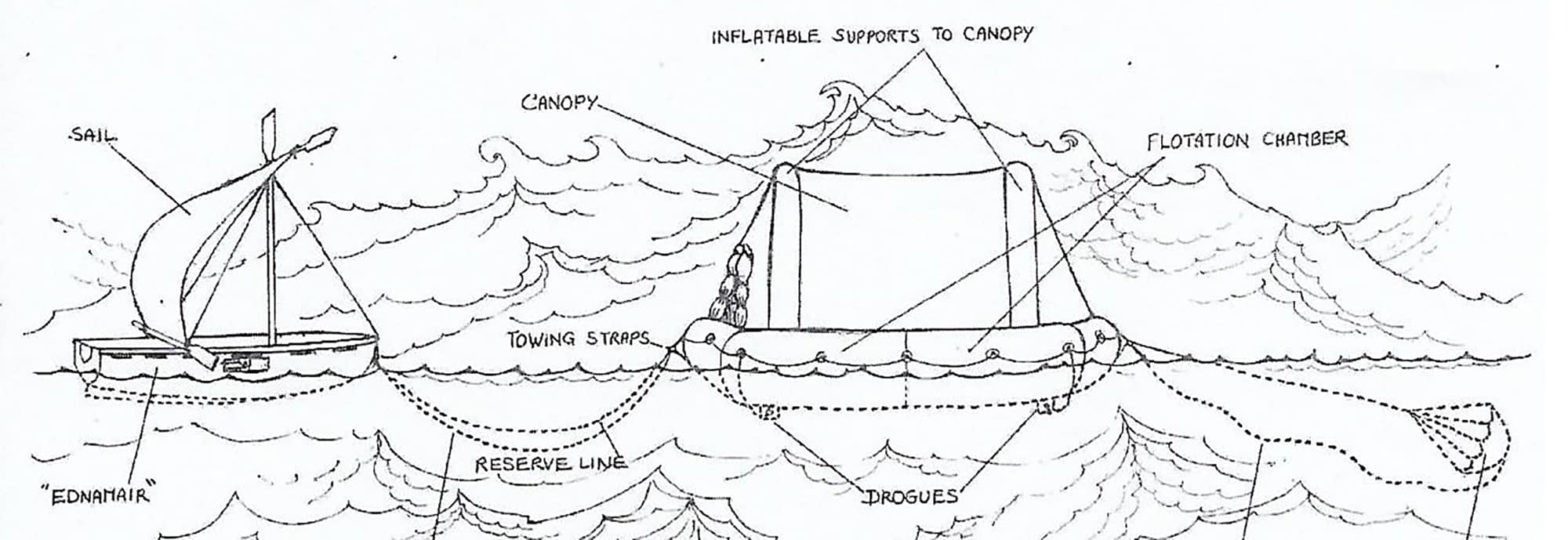By Lynne Vosper.
Lyn and Dougal Robertson were struggling dairy farmers who decided to sell their farm at Meerbrook, near Leek in Staffordshire and to purchase a boat to sail around the world with their family, 16-year-old son Douglas, daughter Anne, 18, and twin sons Neil and Sandy, aged nine. It all started when Neil said, in all innocence, “Daddy’s a sailor. Why don’t we sail around the world?” The farm was sold in 1970 and the family purchased a fifty-year-old, nineteen-ton, forty-three-foot schooner Lucette in Malta and sailed her to Falmouth in October 1970.
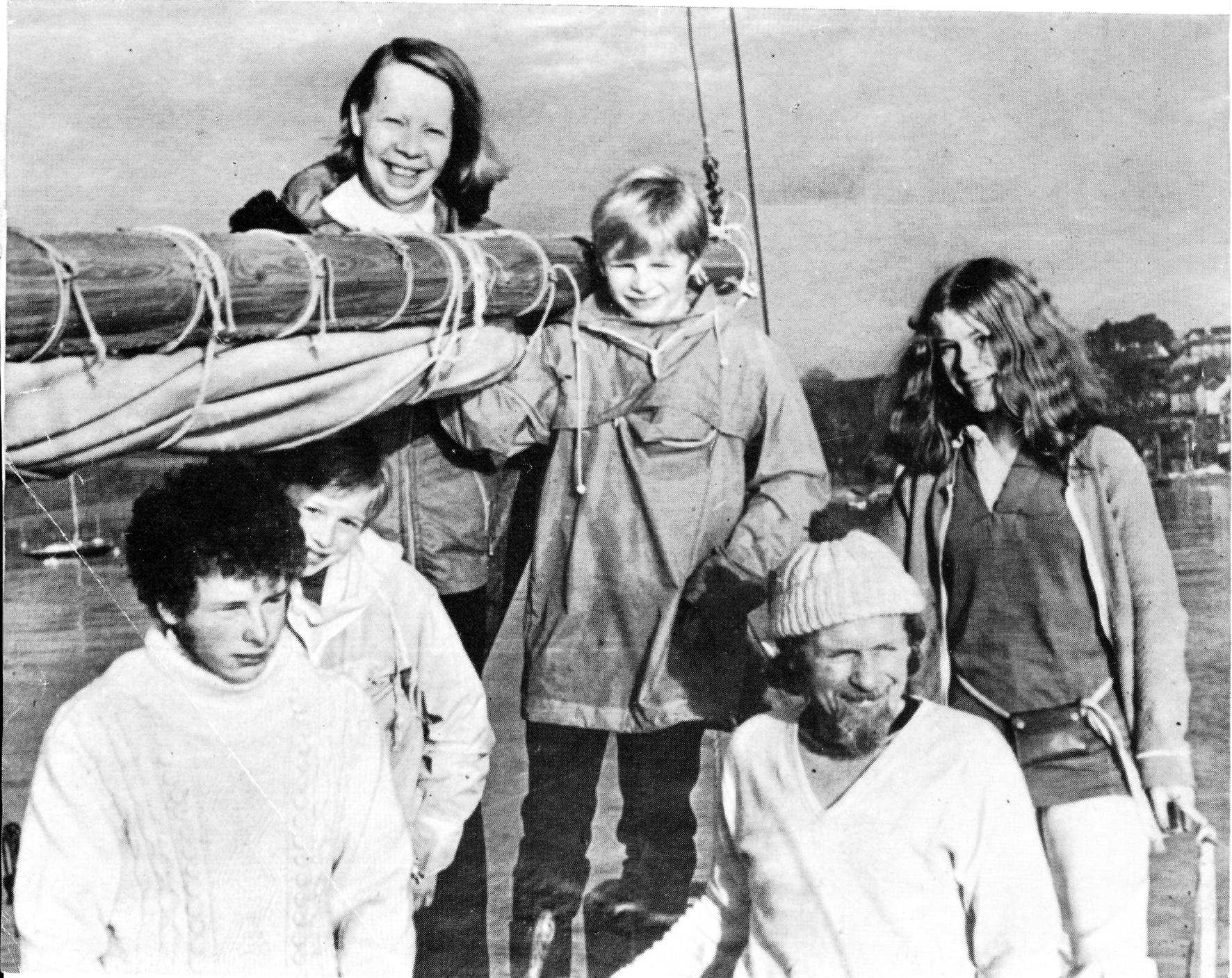
The Robertson Family onboard Lucette in Falmouth before departure. Photograph from ‘The Last Voyage of the Lucette’ by Douglas Robertson.
The family finally left Falmouth on 27 January 1971 on their adventure of a lifetime. It was a poorly planned voyage; although Dougal was a Master Mariner and an experienced sailor and Anne had learned the basics on the voyage back from Malta, the children did not have any sailing experience. Lyn was a practising midwife and a State Registered Nurse. They spent the first eighteen months sailing across the Atlantic and stopping at various Caribbean ports. Anne decided to retire from the voyage in the Bahamas and the family welcomed Robin Williams, a 22-year-old Welsh graduate in economics and statistics on board to join them on their onward voyage to New Zealand, via the Panama Canal and the Galapagos Islands. They were heading for the Pacific Ocean, some 64 million square miles in area and 35,000 feet deep, and with over 30,000 islands spread over almost a third of the earth’s surface.
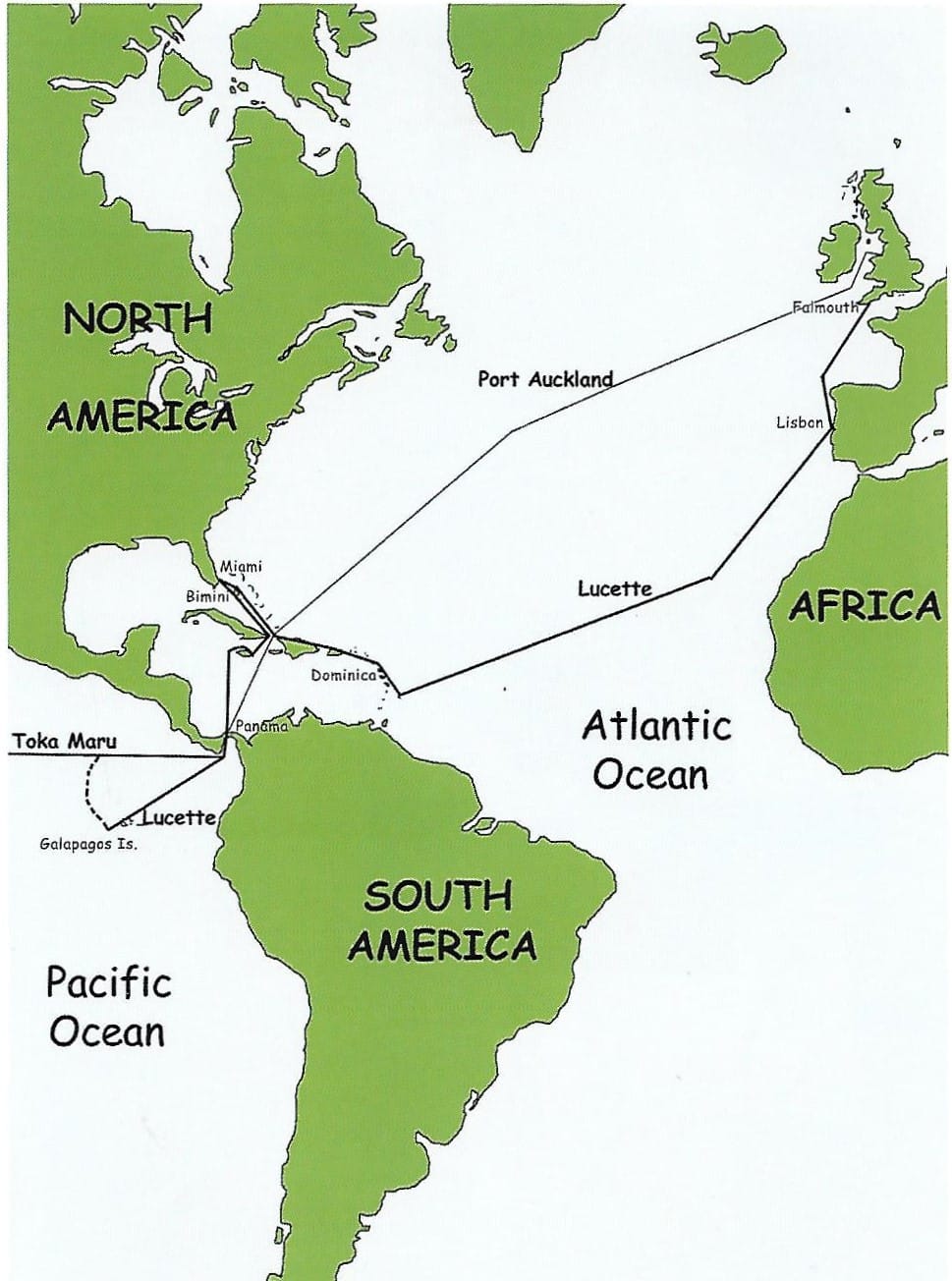
Map of the entire voyage. Illustration from ‘The Last Voyage of the Lucette’ by Douglas Robertson
The Attack – Day 1
After leaving Cape Espinosa on Fernandina Island in the Galapagos on 13 June 1972, they set sail for the Marquesas Islands some 3,000 miles west. They were about 200 miles west of the Galapagos when, at 9.57am on 15 June three horrendous sledgehammer blows hit the hull of Lucette, she had been attacked by three male Orca whales. It only took minutes for Lucette to sink. The family grabbed a few items and abandoned ship and managed to board their inflatable rubber life raft and nine-foot fiberglass dinghy Ednamair. They only had enough water for ten days and emergency rations for three days on the raft. Lyn had taken their papers, the logbook, and a bag of onions, and they had a kitchen knife, a tin of biscuits, ten oranges, six lemons, half a pound of glucose sweets and flares. Lyn had brought her sewing box which proved to be a treasure trove of useful items. They had no maps, compass or instruments and nobody knew they were missing. Their fight for survival had begun.
Castaways – Day 2
Dougal decided to head north for the Doldrums where there would be rain that they could collect for drinking water, and they might be closer to shipping lanes and be able to catch the counter current back to America. The survival raft was eight-foot by six-foot and was in poor condition and leaking. There were bellows to keep the raft inflated but they became broken and so Dougal, Douglas and Robin took turns to blow it up by mouth which was exhausting. They bailed out the Ednamair and worked on the jury rig using a paddle, an oar, and a makeshift sail to convert the dinghy into a tug which they used to tow the raft stern first.
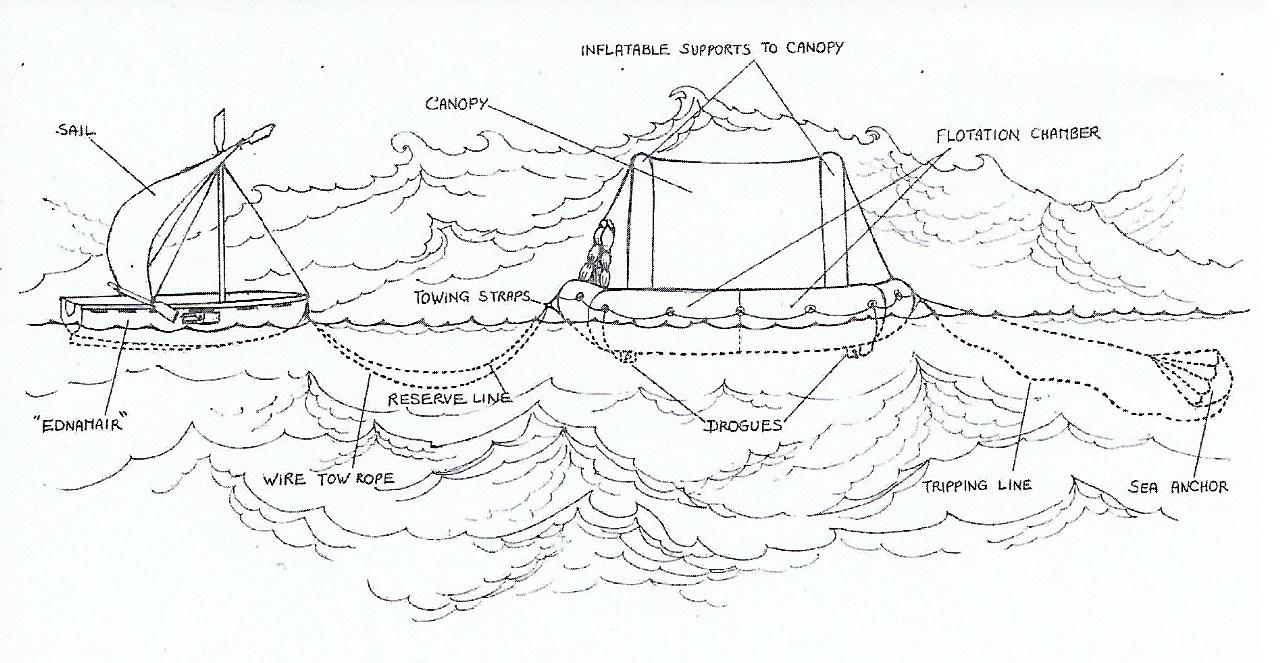
Ednamair towing the raft stern first. Illustration from ‘Survive the Savage Sea’ by Dougal Robertson.
Hunger and thirst were the greatest problems to be overcome. The group had several cans of water and the few rations they had managed to salvage, which lasted them about six days. They ate flying fish that landed in the raft and the dinghy, and caught dorado but Turtle became the mainstay of their diet. They ate the meat and eggs and drank the blood. The raft was leaking, and they were all sat in water up to their chests, giving them saltwater boils. They used the wind and current to their advantage, heading to the northeast towards Central America.
Every day was a challenge with some days more memorable than others, with details of each day of the ordeal recorded in Dougal’s improvised logbook written with a biro found in Lyn’s sewing box.
Day 3 – A flying fish landed in Ednamair, Lyn marinated it with lemon juice. Neil and Robin had terrible sea sickness.
Day 4 – The leaking raft needed topping up with air more often.
Day 5 – Leaks found and repaired in the raft.
Day 6 – A huge 35lb Dorado landed in the dinghy so there was raw fish for breakfast, and plenty left to cut into strips to dry.
Day 7 – Wednesday 21 June. Heavy rain, allowing cans and bags to be filled with water. There was great excitement when Douglas spotted a cargo ship a few miles away from their position. Two parachute rocket flares and three hand flares were used but the Straat Cook failed to see them and sailed on by, to the huge disappointment of all onboard the raft.
The first turtle was caught later that day and was killed taking great care not to spill any blood into the sea that would attract sharks.
Day 8 – Breakfast of turtle steaks and eggs.
Day 10 – By now everyone had saltwater boils, there was not much water left and the raft needed to be constantly inflated.
Day 11 – Hoping for rain. Hoped to be in the rain-bearing doldrums in a few days.
Day 13 – In desperate need of water. Sharks stole fish from the fishing line.
Day 14 – The raft was in even more poor condition, there was water flooding into it and a need for constant bailing. It was the beginning of the end for the raft. Caught a small turtle. Caught the blood in bailers and drank it.
Day 15 – Heavy rain at last enabling them to fill all the containers. The dinghy broke away from the raft. Dougal dived in and swam to retrieve it, somehow finding the energy. Luckily, he escaped the sharks and was utterly exhausted. It was at this stage that Lyn suggested using the water from the bottom of the dinghy in the form of enemas. It was too foul to drink but would allow their bodies to absorb water. Everyone except Robin accepted the enemas. Douglas crafted the makeshift enema equipment.
Day 16 – All on board were in very poor physical condition with sores, boils and sunburn. Still raining.
Day 17 – This was a significant day. It was the day the bottom of the raft virtually disappeared, and they had to transfer to the dinghy. They salvaged what they could from the raft including flotation pieces to be secured to the bow of Ednamair and the canopy to give them shelter. They were unable to move places without planning, to maintain an even keel. Each person had their allotted place.
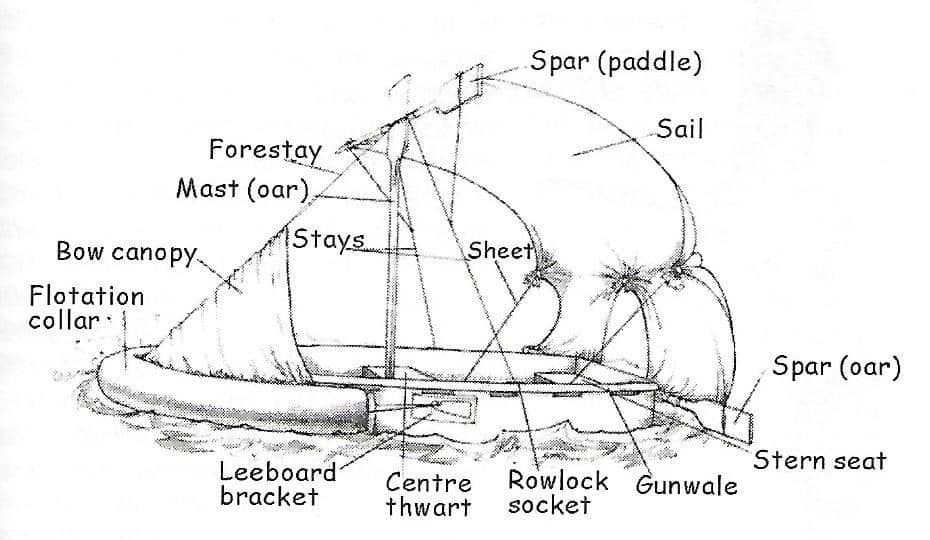
Ednamair under way on Day 17 following the sinking of the raft. Illustration from ‘The Last Voyage of the Lucette’ by Douglas Robertson.
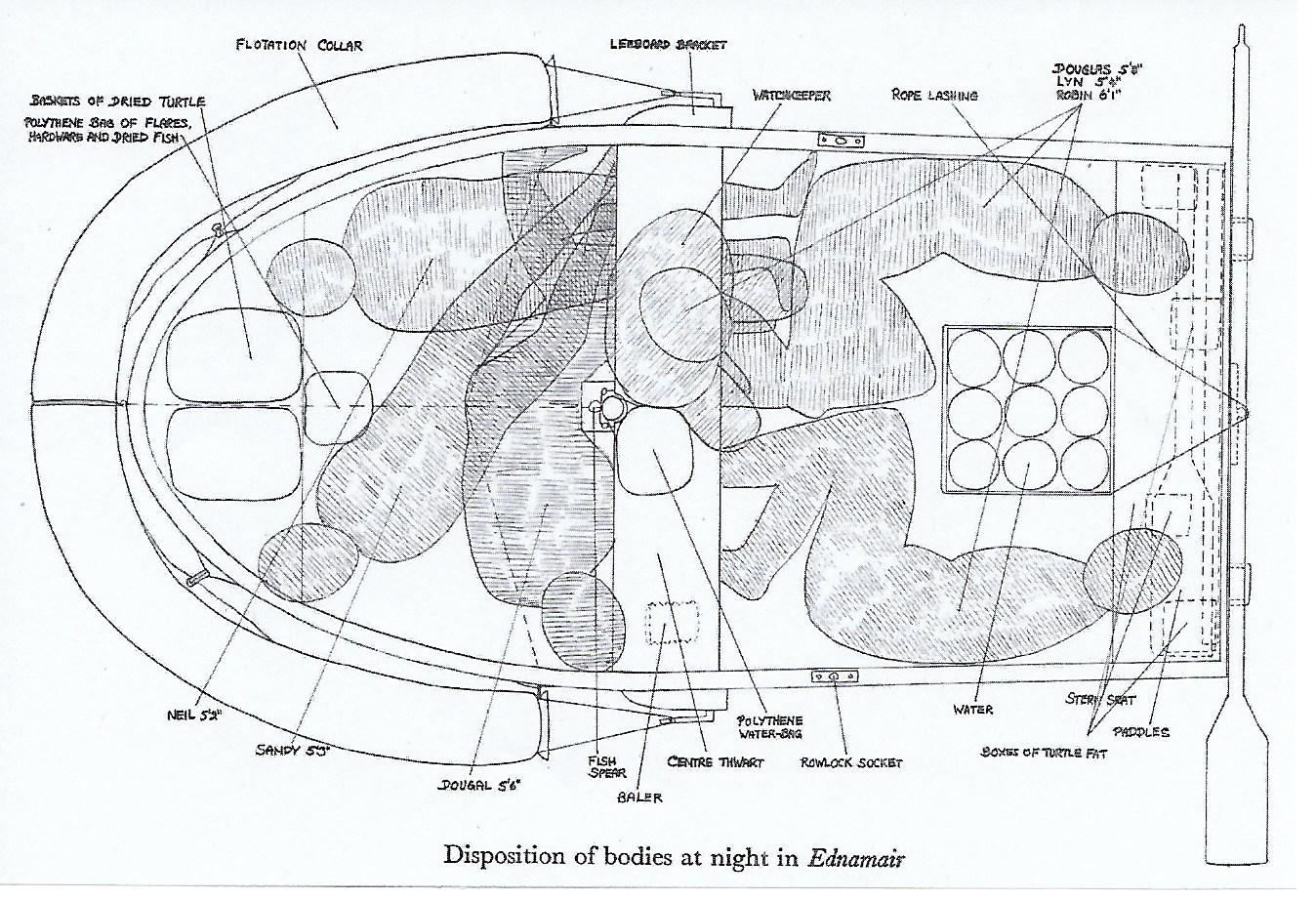
Illustration from ‘Survive the Savage Sea’ by Dougal Robertson.
Day 18 – A tasty breakfast of flying fish, turtle meat, mixed with pieces of turtle fat. Saw frigate birds and storm petrels. Clothes were disintegrating causing sunburn.
Day 19 – A blue-footed Booby landed on Douglas’s shoulder.
Day 20 – 4 July was Lyn’s birthday. Birthday feast of fresh turtle meat, dried turtle meat and dried dorado, with water to drink. Sang ‘Happy Birthday’ to Lyn.
Day 21 – The sea anchor and float broke away. Douglas rowed after it in a feat of sheer endurance, taking 35 minutes of rowing to retrieve it. That afternoon Douglas saw a green flare often used by submarines on manoeuvres, but nothing came of it.
Day 22 – Caught a large turtle. Had to drink the blood quickly before it coagulated. Saved the deep yellow fat. There was a terrible storm and torrential rain.
Day 23 – Still torrential rain requiring constant bailing. They were in a desperate situation and had to bail for their lives. Douglas told everyone to sing to keep warm. A miracle happened, the wind fell silent, and rain stopped. The wind changed direction. Somehow, they had survived the worst night yet.
Day 24 – Still raining and lightening all around them.
Day 25 – Food becoming short, but large turtle caught. With more food and water all were improving physically and mentally.
Day 26 – Another stormy day. Lyn planned more enemas for herself and the twins.
Day 27 – Turtle oil made from the fat for use in enemas and sooth damaged skin.
Day 28 – By morning there was a rough southerly swell with 20-foot waves. Continuous bailing needed. Heading north-east.
Day 29 – This was the day that Dougal caught a five-foot Mako shark, hauled it on board and cut its head off. The severed head closed its mouth on Douglas’s hand and drew blood. He kept the teeth. Progress eastwards was improving.
Day 30 – Douglas spotted the Pole Star so they knew they were back in the northern hemisphere.
Day 31 – An enormous shark bumped the boat. Food stocks were boosted by catching a turtle.
Day 32 – Here was a shortage of water again, but a 20lb dorado was caught.
Day 33 – Eat or be eaten was the law of survival at sea. Three large dorado were caught, giving much needed fluids, helping to relieve the severe thirst of all.
Day 34 – Surviving on fish, eating the raw meat, sucking on the bones and eyes to get fluid.
Day 35 – Huge deluge of rain. Filled the containers, tins and plastic bag with water. Enemas for everyone for digestive reasons. Found five holes in the flotation collar.
Day 36 – The seas were rough and squally. Clothes were tattered and threadbare, but Lyn washed and mended them. The twins were very thin, Neil was emaciated, and Sandy had a cough, possibly pneumonia. If he did not improve, they would have to start rowing with or without reserves of water.
Day 37 – Dougal almost capsized the dinghy trying to drag a turtle onboard. They were approaching the direct route between Panama and Hawaii where there was a greater chance of seeing a ship. Sandy’s cough had become worse and the prospect of rowing the estimated 350 miles to land became more pressing. Land was about 15 days away and there was probably enough dried meat and fish to last.
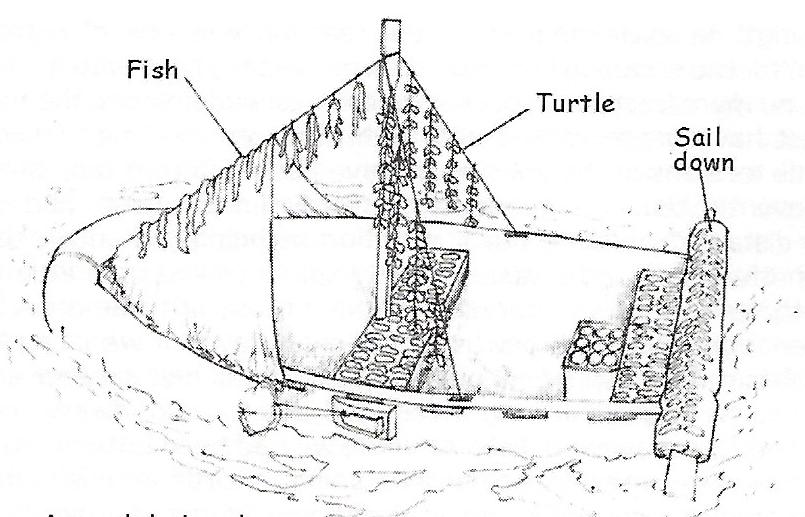
Drying Fish. Illustration from ‘The Last Voyage of the Lucette’ by Douglas Robertson.
The Rescue – Day 38
While planning to draw up a rowing rota, Dougal spotted a ship coming towards them. He waved a red flare and the torch. The ship gave a prolonged blast on her whistle, they had been seen and they were going to be saved.
On 23 July 1972, 38 days into their trip in the Ednamair, they were finally picked up after a Japanese fishing trawler, the Toka Maru II, on her way to the Panama Canal, spotted their distress flare. The Japanese sailors looked in disbelief. They were going to cast off the Ednamair but after signalling that they wanted to keep the dinghy, they emptied out all the bad smelling meat and other contents and brought her on deck. The Japanese crew looked after everyone well.
They had travelled over 750 miles by raft and dinghy and had about 290 miles left until they would reach land. When they arrived in Panama on 28 July 1972 the world press was there to greet them. Robin flew back to England and the Robertson family came back by ship, the MV Port Auckland. Their daughter Anne was waiting back in England, and the family were soon all together again.
It was their spirit of comradeship, ingenuity, love for each other and sheer determination to survive that brought them all home. It was an experience none of them would ever forget.
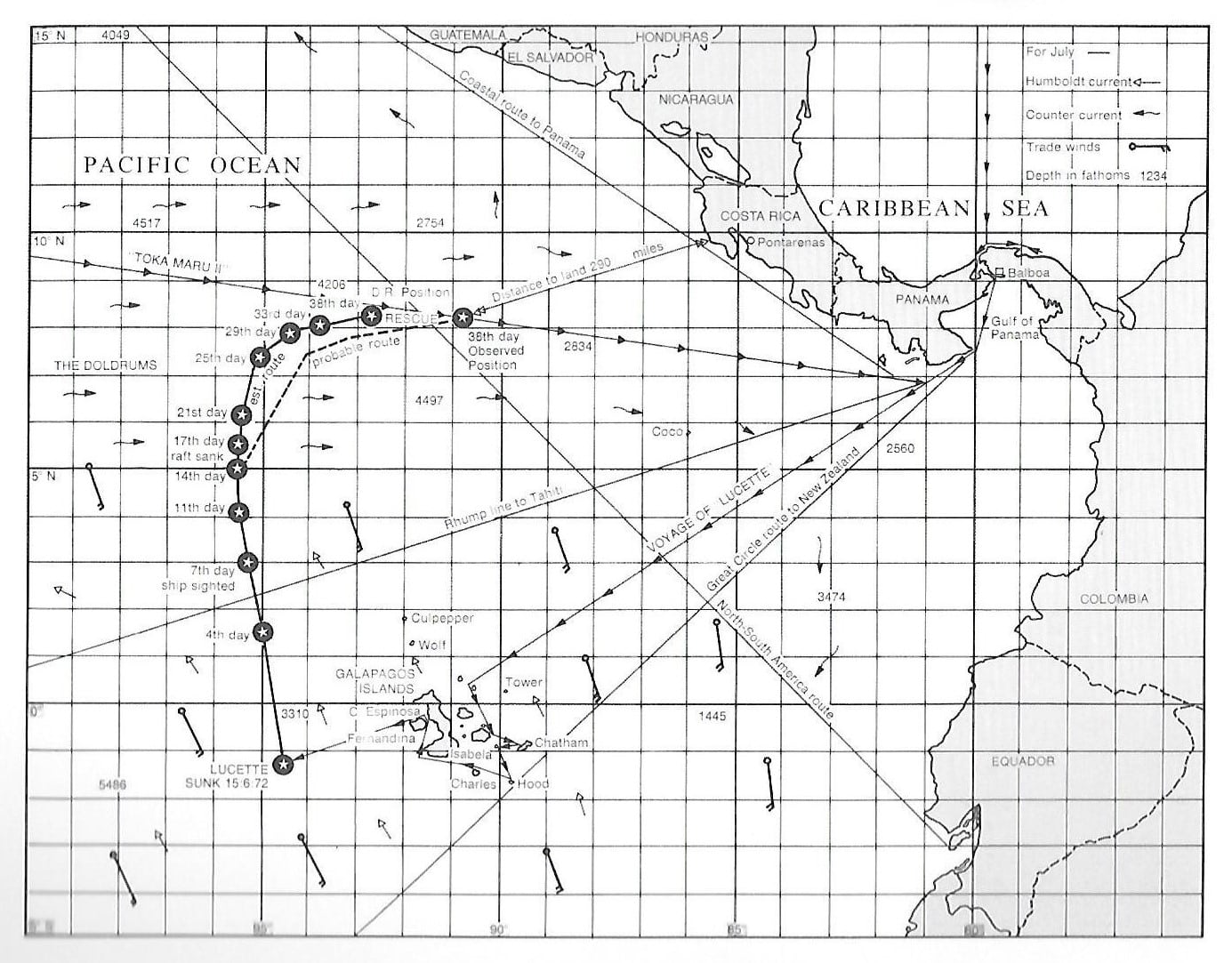
The track of the survivors’ drift in the Pacific, after the loss of the Lucette. From ‘The Last Voyage of the Lucette’ by Douglas Robertson.
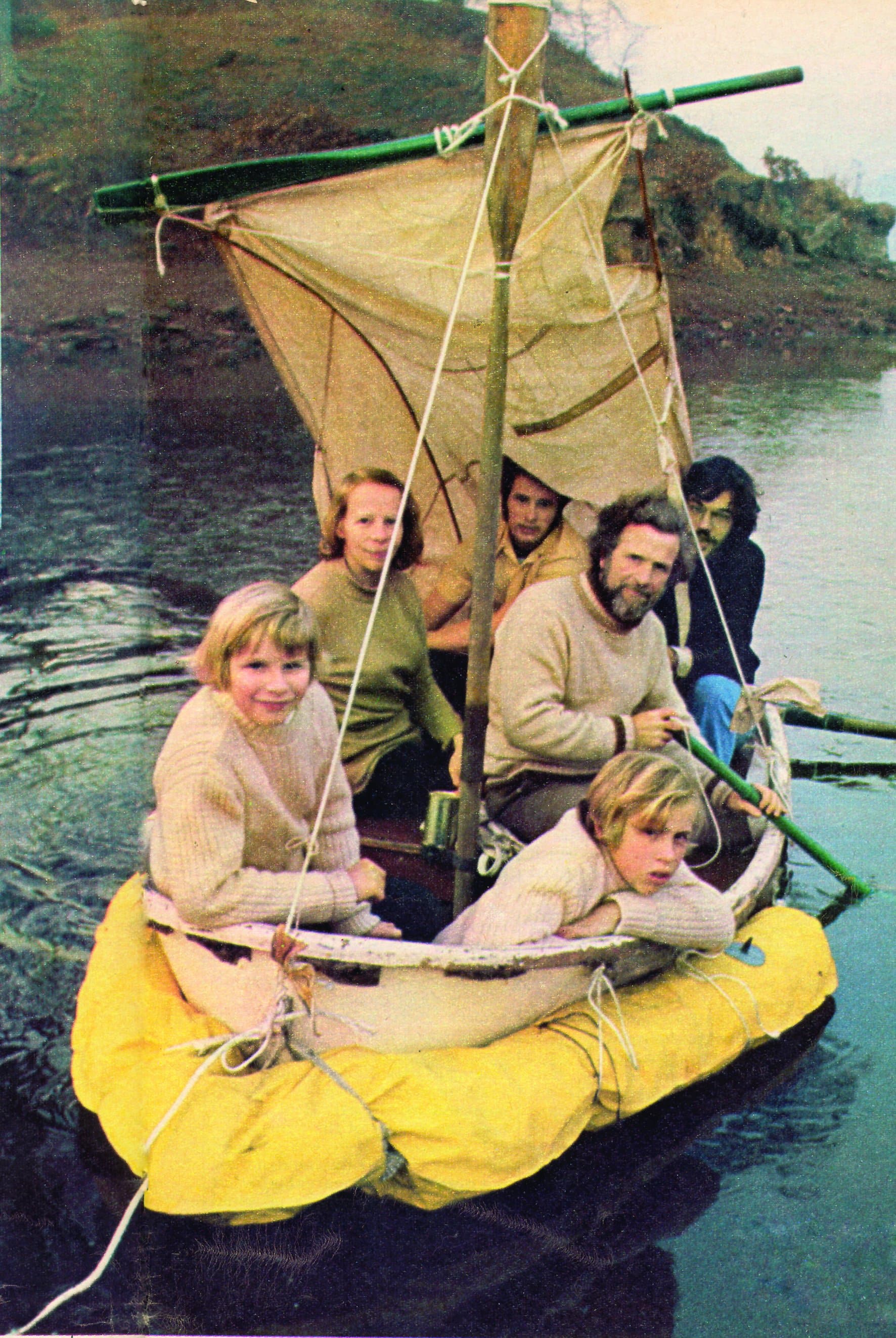
A photograph taken after the rescue to show how everyone fitted into Ednamair. Photograph from ‘The Last Voyage of the Lucette’ by Douglas Robertson.
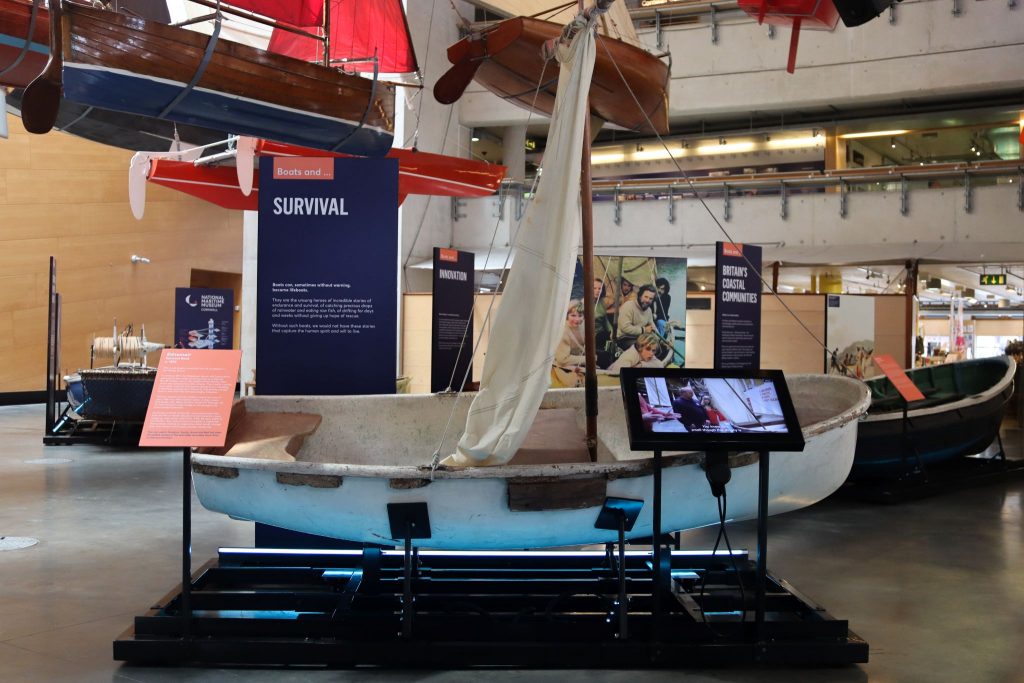
Ednamair on display at National Maritime Museum Cornwall.
What happened to the Ednamair
The Ednamair was named after Lyn’s sisters, Edna and Mary. Edna had given the family the money to buy the dinghy.
For many years after the rescue the Edmamair had been in the care of Edna, but later was brought to Falmouth where she had begun her voyage and was donated to National Maritime Museum Cornwall. On 26 November 2008, Douglas Robertson gave a lecture entitled ‘The Last Voyage of the Lucette’ which was held at the museum.
Other artifacts on display include a pressure cooker weight from Lyn’s sewing box that was used as a fishing weight. Some of the teeth from the 5-foot Mako shark were kept as a trophy. Turtle Oil, saved by the Robertsons’ from their ordeal, was an extremely valued resource made by melting turtle fat in the sun. The oil was used to rub onto saltwater boils, drunk as a warming tonic, mixed with fish and turtle meat to make a stew, and used as an enema. The Enema Tube was cut from the boarding ladder of the life raft and was a good way of rehydrating the family using the dirty water from the bottom of the boat.
Ednamair and the Robertsons
The Museum is celebrating the 50th anniversary of this incredible story of human endurance with a talk by Douglas Robertson. Hear, in his own words, what happened on the 15th June 1972 and the following 38 days as the family fought to live. Douglas will be joined by the other surviving members of the Robertson family for a panel discussion and an audience Q&A.
Further reading
We have two books for sale on our online shop, written by Dougal and Douglas. Every purchase supports the Museum.
‘Survive the Savage Sea’ by Dougal Robertson (1973) – available via our online shop.
‘The Last Voyage of the Lucette’ by Douglas Robertson (2005) – signed copies available via our online shop.
The Bartlett Blog
This article has been written by Lynne Vosper to commemorate the 50th anniversary of the rescue of the Robertson family following the sinking of their schooner Lucette in the Pacific and tells how they survived in their raft and dinghy Ednamair, which is on permanent display at the National Maritime Museum Cornwall. In one of the pockets of the raft was an instruction book entitled ‘Living in the Liferaft’ and this became Dougal Robertson’s logbook for the duration of the 38 days they struggled to survive. He wrote all over the pages of the book and his notes formed the basis of two books, ‘Survive the Savage Sea’ by Dougal Robertson (1973) and ‘The Last Voyage of the Lucette’ by Douglas Robertson (2005).
The Bartlett Blog is written and produced by the volunteers who staff The Bartlett Maritime Research Centre and Library of National Maritime Museum Cornwall. The 50th Anniversary of the Robertson Family Rescue was written by Lynne Vosper.
The Bartlett Library holds a Collection of over 20,000 volumes and offers access to one of the finest collections of maritime reference books, periodicals and archival material. The Bartlett Blog reflects the diversity of material available in The Bartlett Library.
